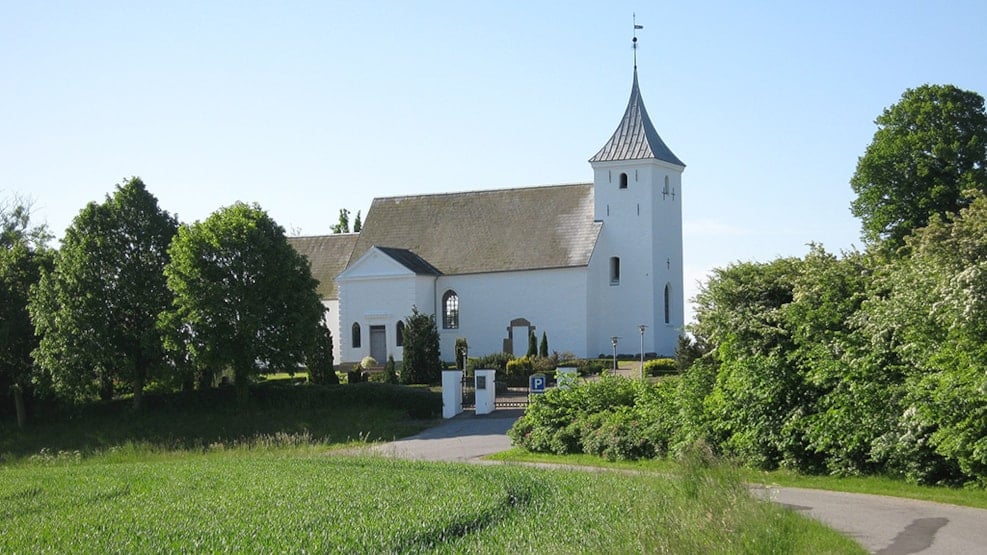
Vær Church
This village church near Stensballe in Horsens is one of the most beautifully located churches in the region. For centuries, the church has been owned by the nearby estate of Stensballegaard and is perhaps best known as the final resting place of one of Denmark's most famous figures in history.
Beautiful Romanesque church
Vær Church is one of the many Danish churches built in the period leading up to the year 1200. The church's chancel and nave date back to this time, constructed from granite blocks. The tower and porch were added in the late Middle Ages in the 1500s.
The church stands beautifully whitewashed, surrounded by impressive nature with hills and lakes. At the entrance to the porch, visitors should turn around to enjoy the stunning view of the landscape, particularly the nearby wildlife reserve, Nørrestrand. Vær Church is located on a hilltop, naturally bordered by smaller ponds and other landscape features.
Although Vær Church is considered a village church, it has never actually been situated within a village. Archaeological finds in the area indicate settlements from the Iron Age, and during the Viking Age, it was referred to as Torsdal—a place likely dedicated to the worship of the Norse god of thunder, Thor. The current church's location is probably linked to its role in the Viking Age's pagan beliefs.
The church interior is bright and inviting. While it lacks many original elements, it features a beautiful Romanesque baptismal font. Some of the furnishings (altar and pews) date back to the Louis XVI style of the 1700s, which is rarely seen in Danish churches, and it is this period that visually influences the church space.
Stensballegaard's church
During the Reformation, when Denmark transitioned from Catholicism to Protestantism, Danish churches were confiscated by the king and often sold to wealthy individuals after a few years. Vær Church was sold to Stensballegaard, which owned the church from the 1500s until 1971. Consequently, Vær Church was one of the last privately owned churches in Denmark and has an unusually stable ownership history.
The influence of Stensballegaard is evident when visiting the church, which is best described as an estate church. In the porch, you can see tombstones for the first owners of the church from Stensballegaard, Folmer Rosenkrantz and Margrethe Gyldenstjerne, as well as other gravestones related to the estate. The stones are filled with intricate details and are exceptionally well-preserved, considering they date back to the 1500s.
Inside the church, there are memorial plaques, coats of arms, and other items that showcase the connection to the estate. The church's most notable attraction is on the left side when you enter the nave. Here you can see the burial chapel of Peder Griffenfeld and Frederik Krag.
About Griffenfeld and Krag
Peder Griffenfeld is a legendary figure in Danish history. He was a powerful and intelligent statesman who served under the kings Frederik III and Christian V. He steadily rose through the ranks, was made count of the island Samsø, and became the Chancellor of Denmark, becoming the most powerful person in the country after the king. However, his power led to his downfall, and he was sentenced to death for abuse of power and treason. Griffenfeld is elegantly buried in Vær Church in a leather-covered coffin with memorial plaques.
Griffenfeld's daughter married Frederik Krag of Stensballegaard, which explains why Griffenfeld is buried here.
Baron Frederik Krag was a wealthy nobleman and official. Like Griffenfeld, he quickly rose through the ranks and was appointed as the viceroy (the king's deputy) in Norway, which was then part of Denmark. Frederik Krag made a significant impact in the local area around Stensballe, remodeled the estate, and also owned the island of Endelave.
On Krag's coffin is a bust of him wearing the chain of the Order of the Dannebrog. His coat of arms is engraved on the coffin. Above the coffin is a beautiful memorial plaque with information about Krag's life and work.
Would you like to visit Vær Church?
Vær Church is open from morning bell ringing to evening bell ringing. You are welcome to visit the church if it is not in use for services or other religious activities.
When visiting the church, consider taking a walk in the surrounding area. You can take a two-kilometer round trip around Vær Lake along the path Værstien, via Amballevej, Meldrupvej, and Værvej. Vær Church is situated on a hilltop above the lake.
You can also visit the church as part of a cycling or hiking trip around the Nørrestrand wildlife reserve.
After your visit to the church, you might consider dining at the restaurant at Stensballegaard Golfklub, located at (and owned by) Stensballegaard Estate.
More historical attractions
Kystlandet offers many exciting historical attractions, ranging from ancient history to industrial history, including museums, architectural works, and natural attractions. This page can provide inspiration for historically interesting experiences near Horsens, Odder, and Juelsminde.